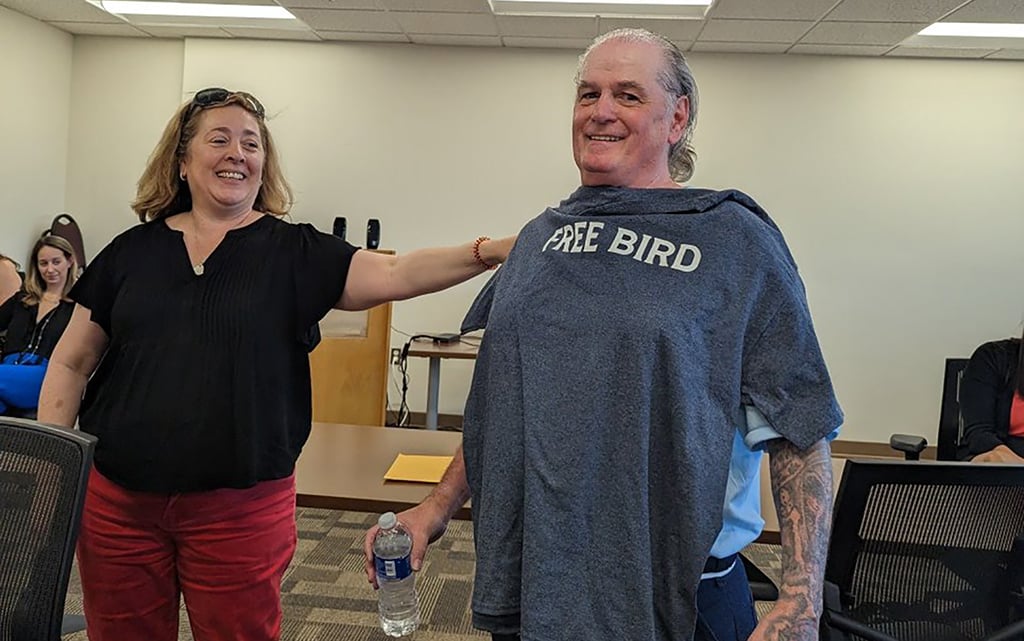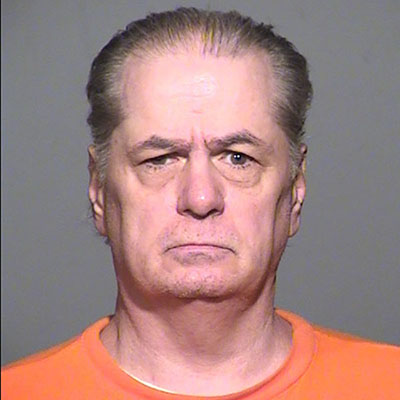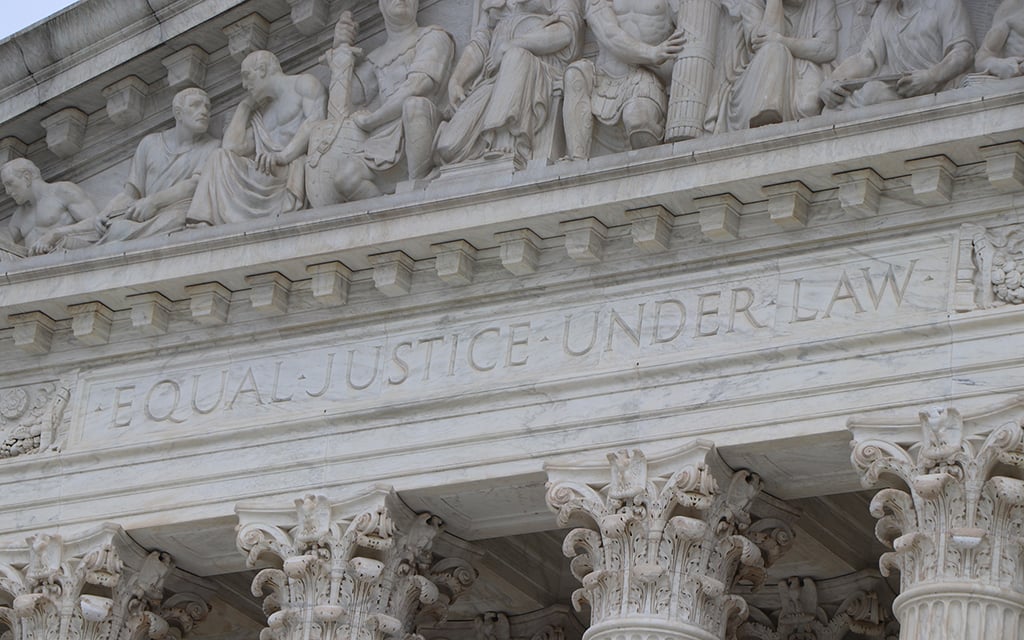
Supporters drape Barry Jones in T-shirt that summed up his situation in June, when he was released from Arizona’s death row, where he spent 28 years for a crime that state officials now say he did not commit. (Photo courtesy Andrew Sowards)

Former death row inmate Barry Jones, kneeling in front, is reunited with family, including children and grandchildren, after his release in June from the Arizona prison system, where he spent almost three decades on death row. (Photo courtesy Andrew Sowards)
WASHINGTON – For Barry Jones, the compensation for spending 28 years on Arizona’s death row before his release in June could come out to about $10 a day.
If he’s lucky. Private donors have to cough up that much first.
A GoFundMe campaign set up by Andrew Sowards, a retired criminal investigator who was part of Jones’ defense team had raised $44,635 as of Wednesday with a goal of $106,360 – or $10 for each of the 10,636 days Jones spent “wrongfully incarcerated” in Arizona state prisons.
“I don’t really expect to hit this goal, I just think it puts it all in some perspective,” Sowards said in a GoFundMe update. “This seems like a number that should have some kind of meaning behind it.”
Jones walked out of prison on June 15, after 29 years behind bars – 28 of them on death row – for a crime the state now says he did not commit: The May 2, 1994, sexual assault and murder of 4-year-old Rachel Gray, his girlfriend’s daughter, in Tucson.
As part of a deal with the state, Jones pleaded guilty to second-degree murder for his failure to seek prompt medical attention for Rachel when she appeared ill. He was sentenced to 25 years on the charge, then released for time served.
“Mr. Jones has been held more than accountable,” said Pima County Attorney Laura Conover, whose office originally prosecuted Jones.

Barry Lee Jones in a mug shot from prison, where he spent 29 years before his release in June. (Photo courtesy Arizona Department of Corrections)
Conover said in a recent interview that Jones has been punished to the most severe degree possible, and had evidence of his innocence not been brought forward, “He would have been executed.”
Jones always maintained his innocence in Rachel’s death. An autopsy determined the death a homicide due to blunt abdominal trauma, an injury that prosecutors suggested occurred on May 1, when Jones had taken the girl for several short trips around town in his van.
When Rachel was nonresponsive on the morning of May 2, Jones and the girl’s mother, Angela Gray, took her to the hospital where the child was pronounced dead on arrival. Gray was convicted of reckless child abuse in the case for failure to seek immediate medical care for Rachel. She was released in 2003.
Jones was convicted on all counts against him in April 1995 and sentenced to death. He pursued several appeals in subsequent years, including one that reached the U.S. Supreme Court in 2022.
In that case, Jones and an Arizona death-row inmate who was convicted in a separate case claimed that they should have been allowed to present new evidence that they had ineffective attorneys, both at trial and on appeal. They argued that poor defense representation led to their convictions.
But the court rejected the claim, with Justice Clarence Thomas writing for the 6-3 majority that allowing such appeals would open the door to “wholesale relitigation” of state cases in federal court. In her dissent, Justice Sonia Sotomayor called the decision “perverse” and “illogical” and said it would lead to defendants like Jones having “no recourse and no opportunity for relief” in death penalty cases.
Monica Haymond, a lecturer and fellow at Harvard Law School, was one of the lawyers who represented Jones when his case reached the Supreme Court. She said of Thomas’ ruling toat, to the court, “it didn’t matter that Barry was innocent.”
But by the time Jones’ case returned to federal district court, Arizona had a new attorney general – Kris Mayes – and prosecutors were willing to listen to new evidence presented by his attorneys. Haymond said Mayes’ election last year “played a vital role in making justice happen.”
In court documents filed in May, defense attorneys picked apart the state’s case against Jones. They said police focused on him as the suspect within hours of Rachel’s death, to the likely exclusion of others. Several witnesses told police that Rachel may have been hit by other family members or boys in the neighborhood, one of whom reportedly hit her in the stomach with a metal bar – exactly the type of injury prosecutors say killed her.
Jones’ conviction turned on testimony that Rachel’s injuries occurred the day before her death, when she spent part of the day in Jones’ care, but other doctors subsequently said the injuries could have come days earlier.
Prosecutors also said Jones’ trial attorney failed to follow up on conflicting testimony from Rachel’s older sister. She told police, and testified at her mother’s trial, that Jones and Rachel took two trips in his van on May 1 and that Rachel was happy and unharmed after both trips. But at Jones’ trial she said there were three trips in the van and that she did not see Rachel after the third.
The state agreed in May that Jones had shown his trial attorney was ineffective, and agreed to drop all charges against him in exchange for a guilty plea to the second-degree murder of Rachel.
“It was a horrible tragedy what happened to Rachel, and he (Jones) served time for the role that he played in that,” Haymond said. “But that doesn’t mean that he shouldn’t get to be a person in society, to have a chance to get back on his feet and to reunite with his family.”
Haymond donated $750 to Jones’ GoFundMe account, one of 626 who have donated so far. She said she gave, in part, because the absence of a compensation program in Arizona for wrongfully convicted individuals makes it important for the community to help “fill the gap.”

Barry Jones on a shopping trip in June, shortly after he was released from death row. (Photo courtesy Andrew Sowards)
“I wish that the state did more to make up for the injustice that it caused,” Haymond said. “It’s especially easy to want to help Barry.”
Sowards started the campaign on June 15, the day Jones was released from prison, to help Jones “reacclimate and get back to his life.” Sowards thought the initial $20,000 goal would be impossible to reach, but when it was met just a few days later he raised the goal to $50,000. As donations climbed past $40,000, Sowards chose the even more “insane” benchmark: $106,360.
Requests to speak with Jones were directed to his lead attorney, Cary Sandman.
Conover said it’s important for everyone to make sure Jones gets his life back on track.
“What the community needs is for Mr. Jones to make the most of his time, to be healthy, to rejoin his family, support his family and be a productive member of society,” she said.
Sandman and Sowards said they are working on helping Jones get permanent housing, a state ID card and a bank account for the money raised on his behalf. When Jones turns 65 in August, the team plans on helping him get situated with Medicare. They also said they want to eventually help Jones find a place to work.
But for now, Sandman said Jones’ focus is rebuilding relationships with his family.
“He is not angry, not bitter. He wants to make use of every minute,” Sandman said.

